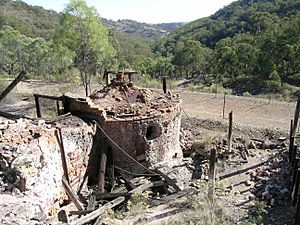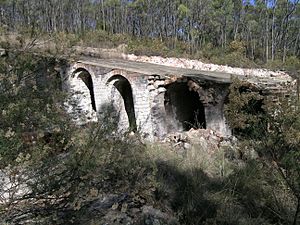Emmaville, New South Wales facts for kids
Quick facts for kids EmmavilleNew South Wales |
|
|---|---|

View of Emmaville
|
|
| Population | 519 (2016 census) |
| Postcode(s) | 2371 |
| Elevation | 890 m (2,920 ft) |
| Location |
|
| LGA(s) | Glen Innes Severn Council |
| County | Gough |
| State electorate(s) | Northern Tablelands |
| Federal Division(s) | New England |
Emmaville is a small town in the New England area of New South Wales, Australia. It is located on the Northern Tablelands, a high plateau. The town is part of the Glen Innes Severn Council district.
Emmaville sits 890 metres (about 2,920 feet) above sea level. In 2016, about 519 people lived in the Emmaville area.
Contents
A Glimpse into Emmaville's Past
Emmaville is on the traditional lands of the Ngarabal people. This area is still very important to them today. The Ngarabal name for this land is "Marran," which means "plenty of leeches."
How Emmaville Got Its Name
In 1872, people found Tin on Strathbogie Station. The settlement was first called Vegetable Creek. This name came from the Chinese market gardens that grew to feed the miners. In the early 1900s, about 7,000 people lived here, including 2,000 Chinese people.
The town was renamed in 1882. It was named after Emma Greville. She was the wife of the state Governor, Lord Augustus Loftus. The old name, Vegetable Creek, is still used for the local hospital.
Early Services and Mining
A school opened in Emmaville in 1875. It had many students in its first year. The school moved to its current spot in 1927.
Emmaville also started the first medical fund in New South Wales. This helped the town keep a doctor and build a hospital.
Tin and arsenic were mined at the Ottery Mine, near Emmaville. This mine started in 1882 after a large tin deposit was found. Today, the site has been cleaned up and is open for visitors.
The Mystery of the Emmaville Panther
Emmaville is famous for a mysterious animal sighting. People called it the "Emmaville Panther." Some thought it was a large black panther. Others believed it was a marsupial lion, an ancient Australian animal.
The creature was seen in February 1958 and many times in the 1950s and 1960s. There are no native big cats in Australia. One idea is that the animal escaped from a traveling circus. The circus owner might not have reported it missing.
Emmaville Today
Today, Emmaville's main activities are tourism, farming, and mining. The town has a Mining Museum. It shows off a collection of minerals and old photos of the town. Fossicking (searching for minerals) is a popular activity for tourists.
This tidy village has a post office and a general store. You can also find two craft shops, a swimming pool, and a caravan park. There are two hotels for visitors. Emmaville also has a pre-school and a public school. The school teaches students from primary grades up to year 12. The Vegetable Creek Hospital in Emmaville has 19 beds for patients.
Local Media
Local news for Emmaville comes from the Glen Innes News. This newspaper publishes both online and in print.
Emmaville also has a community radio station, 2CBD FM. It broadcasts from Glen Innes. You can listen to it on 91.1 FM in Deepwater and 105.9 FM in Glen Innes. The station also streams live online. Volunteers run the station, sharing local news and a variety of music.
Historic Places
Emmaville has some places listed as important heritage sites. One is the Ottery Mine, about 8 km north-east of town. It is listed on the New South Wales State Heritage Register.
People from Emmaville
Many interesting people have come from or lived in Emmaville:
- Frank James Coughlan (1904-1979) was a famous jazz musician.
- Pearl Duncan is a retired teacher, expert in cultures, and an Aboriginal elder.
- Clifford Kwan-Gett was an engineer and doctor. He was a pioneer in creating the artificial heart.
- Thomas James Richards (1882-1935) was an army officer and an Olympian. He was also a rugby union coach and player.
- Debbie Wells (born 1961) was a sprinter. She competed in the Olympic Games in 1976, 1980, and 1984.





